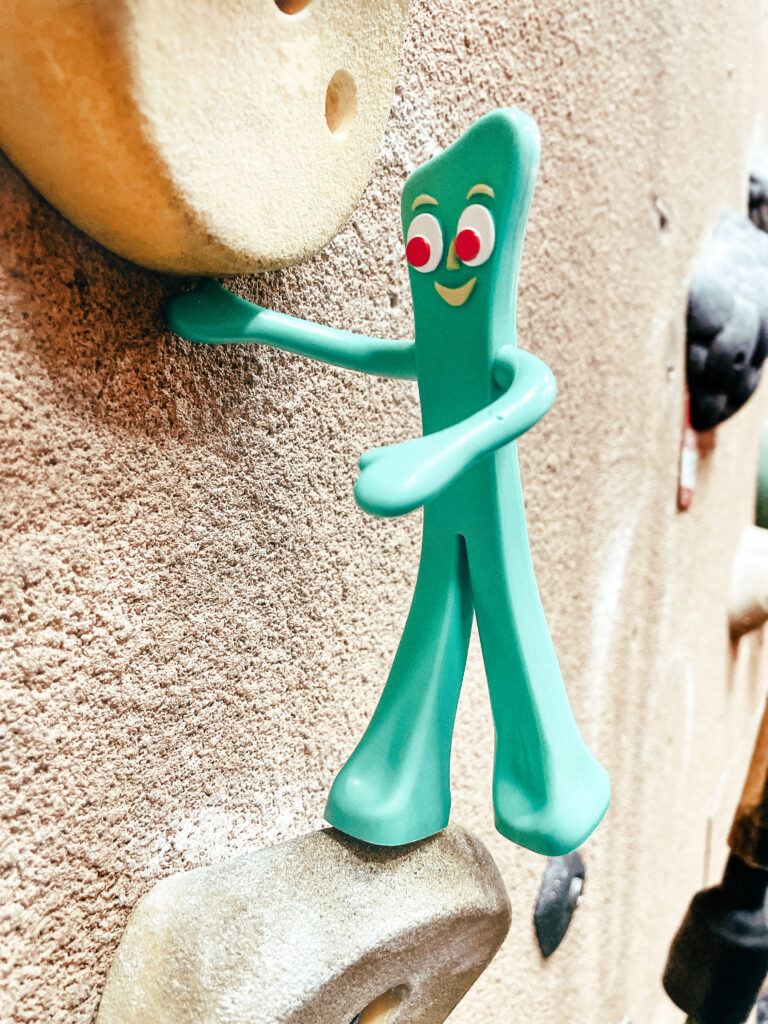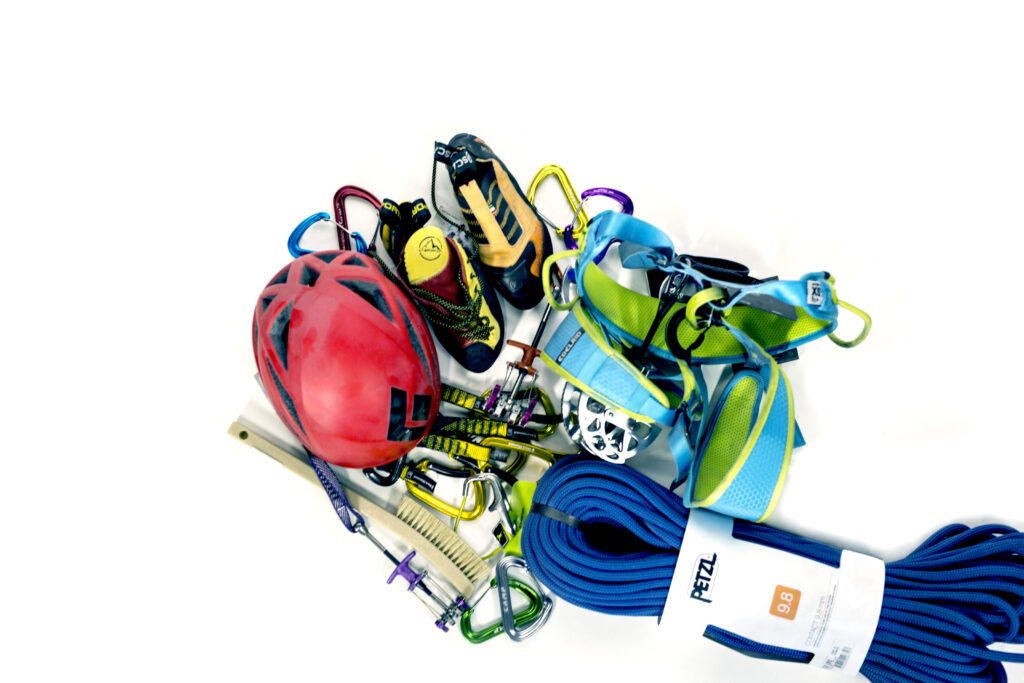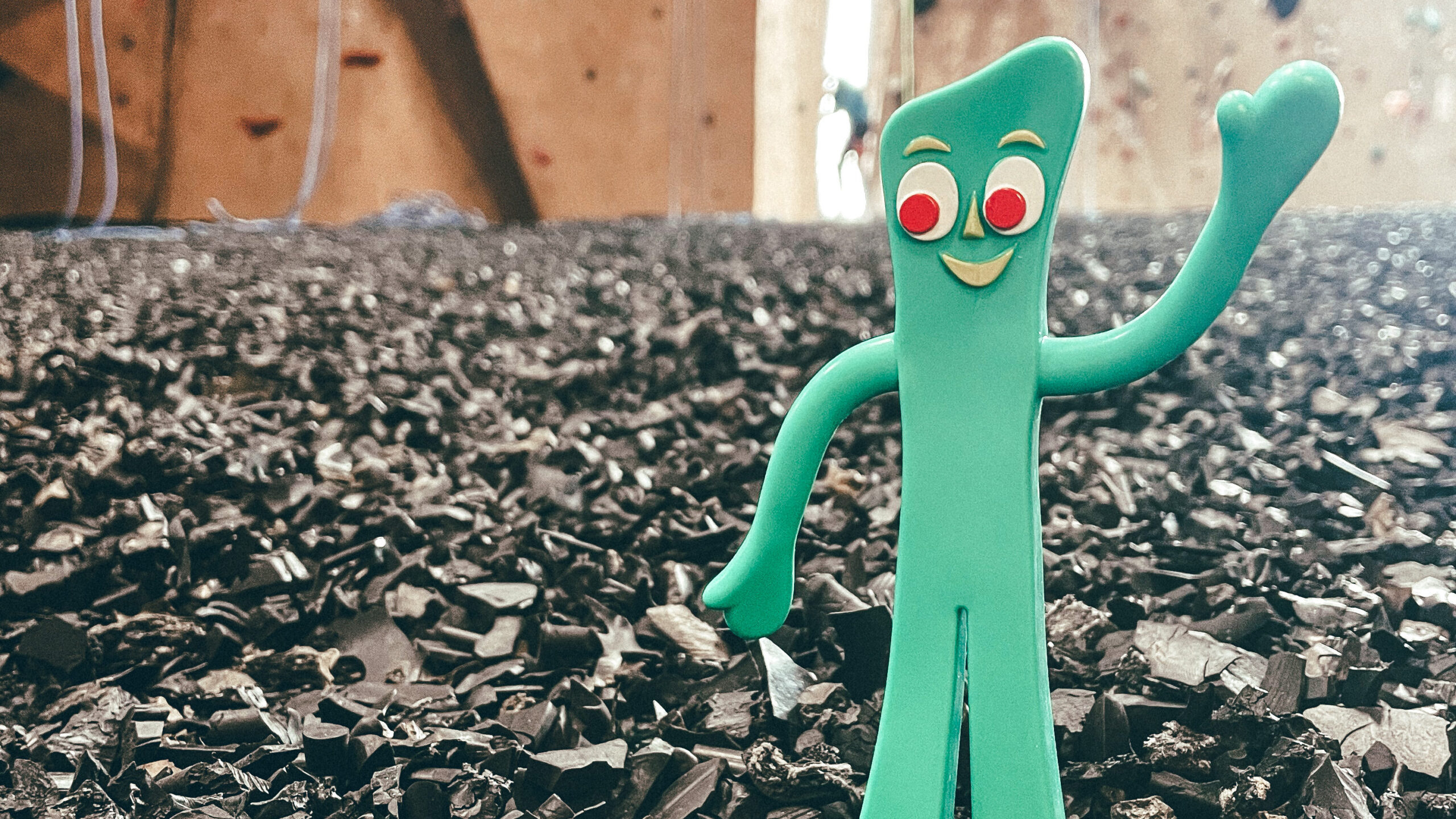You Might Be a Gumby If…
Gumby (noun)
guhm·bee | gu̇mbē
An inexperienced, unknowledgeable, and/or oblivious climber; one who lacks coordination, common sense, or know-how.
Gumby is an American clay animation character created and modeled by Art Clokey in the 1950s. He was the subject of a couple television series, a feature-length film, comic books, and other media. Since his first appearance, Gumby has become a famous example of stop-motion clay animation and a cultural icon, spawning tributes, parodies, and merchandising. Because of the nature of stop-motion animation, Gumby’s movements seemed clunky and awkward. However, he also displayed great flexibility, innocence, imagination, and a sense of adventure.
Therefore, his name has naturally been borrowed to describe a new climber who enters the sport with enthusiasm, a sense of awe, and wonder. But, at the same time, they lack the experience, finesse, and knowledge of more experienced climbers. There is nothing wrong with being classified as a Gumby. Honestly, we have all been there . . . some longer than others. Several of us may just be “perma-Gumbies” or have Gumby-like behaviors and habits that we still carry with us.
For those who would like to identify some Gumby-ness in themselves and perhaps grow as a climber, we have compiled a list of some characteristics that you might want to shed because they could make you look like a Gumby:

1. Wearing socks with your climbing shoes.
I get it! No one wants to put their bare feet into those nasty rental climbing shoes. Therefore, if you are renting a pair (another sure sign of a new climber), then by all means wear socks. However, the purpose of climbing shoes is to give support and feel through a tight fit. Wearing socks cushions and protects your feet, but it takes away from the very characteristics that climbing shoes were meant to enhance. Additionally, the warmth of a foot helps soften the sticky rubber soles and rand of the shoe to enhance grip on those thin edges and when you smear your foot on the wall/rockface. Socks will insulate your foot and diminish this feature also. To get the most out of your climbing shoes, take off those socks, size them a little smaller than your regular shoe size, and lace them tight.
2. Wearing a harness to boulder.
A harness adds weight and restricts your movement. It can also have buckles and loops that could poke, puncture, or imprint on your skin or the landing surface. When bouldering, every fall is a ground fall! Therefore, you will be falling on your harness a lot. However, the main reason to avoid wearing a harness when you boulder is that it is unnecessary. There is no rope to tie into and the harness serves no purpose. When bouldering take off your harness and set it aside (away from the wall and landing zone). It will lighten your load and make you more comfortable.

3. Having extraneous gear clipped to your harness when climbing indoors.
If you are climbing indoors, there is no need to have a full set of quickdraws, prusik cords, a PAS, a water bottle, a nut tool, and four different belay devices clipped to your harness. You can leave them in your backpack or locked away in the trunk of your car. They are only weighing you down and getting in the way. They also make you look like a show-off. “Hey, look at all my cool gear!” Maybe you are practicing or getting in condition for climbing outdoors. Wearing a small, weighted backpack would be less cumbersome, noisy, and ostentatious.
4. Bouncing off the wall while being lowered off a route.
You get to the top of a route or further than you thought possible. Amazed at your accomplishment you let go to be lowered by your belayer or the auto belay system. Excitedly, you begin to kick away from the wall again and again, wildly swinging out as you descend . . . just like you see the S.W.A.T. Team members do in the movies. The only problem is that experienced climbers know that this puts extra stress on the rope, cable, and anchors It also makes it more difficult for your belayer or the auto-belay, and puts anyone near you (either on adjacent routes or on the ground below) in jeopardy of being walloped!
Coming down does not have to be dramatic as what is portrayed in Hollywood when characters descend. Stay in control and simply walk backwards, keeping your feet and legs extended to protect yourself from spinning and/or banging into the wall on the way down. It is safer for you and for those around you. Additionally, it is less stress on the equipment.
5. Not being aware of your surroundings.
It is mentioned in the facility orientation, but it really cannot be overstated: Be aware of your surroundings! It is frighteningly easy to walk underneath someone who is climbing or being lowered from the wall. It is also dangerous to walk between the wall and a belayer. The climber could fall and the belayer might be pulled toward the wall and crash into you. If you are on your phone, talking with friends, or not paying attention, it could cause an unfortunate or dangerous condition. If someone were to land on or crash into you, the falling climbing is more likely to be hurt or the belayer may lose control of the rope. That is one of the reasons headphones are not allowed while climbing at Vertical Endeavors. It is easy to “get lost” in the music, “tune out those around you,” ignore what’s happening, or miss a warning or vital communication. Climbing is inherently dangerous and requires everyone to stay alert.

A Gumby might also be referred to as a newbie or a noob climber. There are so many other things that could make one look like a Gumby while climbing indoors, such as, wearing gloves (usually fingerless) to climb, walking into the gym already wearing your harness (and climbing shoes), having a three foot rope tail after tying in, or asking everyone if they have watched Free Solo. In fact, there are enough Gumbyish qualities that all of us probably display a few from time to time.
There are some characteristics that are extremely dangerous such as putting the belaying end of the rope backwards in a GriGri or Z-clipping a lead route. (If you don’t know what those are, you are likely a Gumby!) But, hope is not lost. If you know you regularly make some or all of these mistakes, you can improve your skills and behavior. By correcting these habits, you will become a safer, more efficient, and less dorky climber. Climbing is a fun, challenging, and worthwhile activity where everyone is welcome and all of us have been a Gumby at one time or another. Let’s continue to grow, learn, and encourage one another.
Look for Part 2 with more Gumbyesque characteristics . . . coming soon!
Climbing is dangerous, it involves inherent and other risks and cannot be eliminated. The information presented here does not describe all of the risks associated with climbing and is not intended to replace or supersede expert instruction and training.
© 2023 Vertical Endeavors, Inc. All rights reserved. The contents of this article, photographs, and graphical representations are protected by U.S. and International copyright laws. Reproduction and distribution, in part or whole, without written permission from Vertical Endeavors are prohibited. The opinions and information contained in this article are for entertainment and informative purposes. They are those of the author and may not represent those of Vertical Endeavors, and do not necessarily reflect the ideas, ideologies, opinions, or points of view of the organization, affiliates, owners, stockholders, partners, suppliers, licensors or staff. Under no circumstances shall Vertical Endeavors or any entity that are, have been, or will be affiliated be liable for any indirect, incidental, consequential, special, or exemplary damages arising out of or in connection with the information contained in this article.

